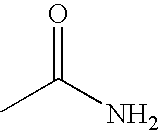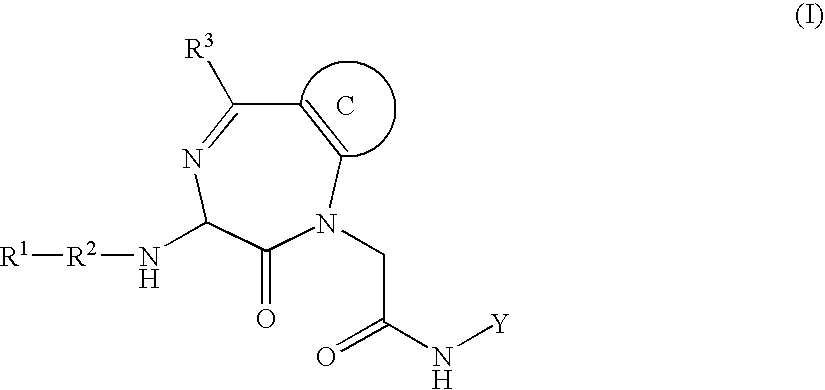Inhibitors of interleukin 1-beta converting enzyme
a technology of interleukin 1 and converting enzyme, which is applied in the direction of peptide/protein ingredients, immune disorders, extracellular fluid disorders, etc., can solve the problems of poor oral absorption, poor cellular penetration and cellular activity, and unsatisfactory pharmacologic properties, so as to improve cellular potency, inhibit the activity of the enzyme, and treat or prevent diseases
- Summary
- Abstract
- Description
- Claims
- Application Information
AI Technical Summary
Benefits of technology
Problems solved by technology
Method used
Image
Examples
example 1
[0213]
(3S)-3-[3(R,S)-1,3-Dihydro-2-oxo-5-phenyl((benzyloxycarbonyl)amino)-2H-1,4-benzodiazepin-1-acetylamino]-4-oxobutyric acid
[0214]
[0215]Step 1. A 0° C. THF solution (30 ml) of 1 (2.4 g 6.22 mmol; prepared as described in Sherrill and Sugg, J. Org. Chem., 60, pp. 730-4 (1995)) was treated with NaH (240 mg, 6.00 mmol of a 60% oil dispersion). After the reaction was stirred for 1 hr at 0° C., methyl bromoacetate (0.6 ml, 6.32 mmol) was added to the reaction and the allowed to warm to room temperature. The reaction was quenched with water (10 ml) and aqueous 10% NaHSO4 (1 ml) and extracted with ethyl acetate (2×). The combined organic layers were dried over anhydrous Na2SO4 and concentrated in vacuo. Chromatography (SiO2, 10 to 3% methylene chloride / ethyl acetate eluent) gave 2.15 g (76%) of 2.
[0216]Step 2. Aqueous 1 N NaOH (3.5 ml, 3.5 mmol) was added to a solution of 2 (340 mg, 0.74 mmol) in methanol and THF (6 ml of 1:1). The reaction was stirred at room temperature for 18 hr. Th...
example 2
[0219]Further data for Example 2 is found in Table 1.
(3S)-3-[3(R,S)-1,3-Dihydro-2-oxo-5-phenyl-((3,5-dichloro-4-methoxybenzoyl)amino)-2H-1,4-benzodiazepin-1-acetylamino]-4-oxobutyric acid
[0220]
[0221]Step 1. MBHA resin (0.63 mmol / g, 4.14 g, 2.61 mmol) was suspended in dimethylacetamide (20 mL) followed by addition of 6 (2.37 g, 4.0 mmol, prepared from (3S) 3-(fluorenylmethyloxycarbonyl)-4-oxobutryic acid t-butyl ester according to A. M. Murphy et. al. J. Am. Chem. Soc., 114, 3156-3157 (1992)), O-benzotriazole-N,N,N′,N′-tetramethyluronium hexafluorophosphate (HBTU; 1.53 g, 4.04 mmol), and DIEA (1.75 mL, 10.0 mmol). The reaction mixture was agitated 3 hr at room temperature using a wrist arm shaker. The resin was isolated on a sintered glass funnel by suction filtration and washed with dimethylacetamide (6×20 mL). Unreacted amine groups were then capped by reacting the resin with 20% (v / v) acetic anhydride / dimethylformamide (2×25 ml) directly in the funnel (10 min wash). The resin was...
example 3
[0226]Further data for Example 3 is found in Table 1.
(3S)-3-[3(R,S)-1,3-Dihydro-2-oxo-5-phenyl(benzoylamino)-2H-1,4-benzodiazepin-1-acetylamino]-4-oxobutyric acid
[0227]
[0228]Step 4. Following a similar procedure as method 1, resin 5 was acylated with 0.5M benzoyl chloride in N-methypyrrolidone (1 mL) and 1.6M DIEA in N-methypyrrolidone (0.35 mL) for 3 hr at room temperature. The acylation step was repeated to yield resin 12. This same methodology was also applied to the preparation of sulfonylamino compounds by replacing benzoyl chloride with sulfonyl chlorides. This same methodology was also applied to the preparation of urea compounds by replacing benzoyl chloride with the appropriate isocyanate.
[0229]Step 5. Cleavage of the aldehyde from the resin 12 and workup gave Example 3 (31.6 mg).
PUM
| Property | Measurement | Unit |
|---|---|---|
| Molar density | aaaaa | aaaaa |
| Molar density | aaaaa | aaaaa |
| Molar density | aaaaa | aaaaa |
Abstract
Description
Claims
Application Information
 Login to View More
Login to View More - R&D
- Intellectual Property
- Life Sciences
- Materials
- Tech Scout
- Unparalleled Data Quality
- Higher Quality Content
- 60% Fewer Hallucinations
Browse by: Latest US Patents, China's latest patents, Technical Efficacy Thesaurus, Application Domain, Technology Topic, Popular Technical Reports.
© 2025 PatSnap. All rights reserved.Legal|Privacy policy|Modern Slavery Act Transparency Statement|Sitemap|About US| Contact US: help@patsnap.com



